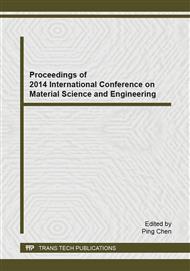p.3
p.7
p.12
p.18
p.23
p.27
p.36
p.41
Adsorption of Lead on the LDO Based on Reconstruction of LDH
Abstract:
The Mg-Al layered double hydroxide (LDH) with carbonate interaction was synthesized by the urea method under hydrothermal conditions and layered double oxide (LDO) was prepared by calcination of LDH. The LDO was used as adsorbents for the removal of lead from aqueous solutions. The X-ray diffraction patterns of the LDO demonstrate that the adsorption is significantly enhanced by reconstruction of its original layered structure in the presence of lead with the memory effect. The process involved a fast adsorption within three hours, followed by slower, more gradual and stable adsorption. The adsorption capability for lead is 6.26 mg/g. The results indicate that the calcined Mg-Al layered double hydroxide is an efficient adsorbent for the treatment of waste water with heavy metal ions.
Info:
Periodical:
Pages:
7-11
Citation:
Online since:
October 2014
Authors:
Keywords:
Price:
Сopyright:
© 2014 Trans Tech Publications Ltd. All Rights Reserved
Share:
Citation:


